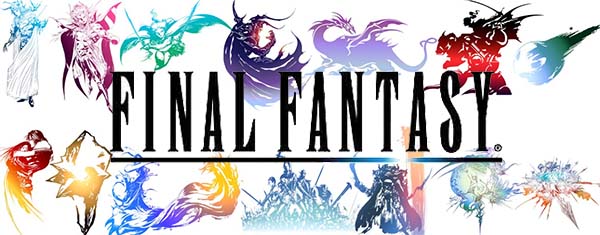
Despite being great games, the character development systems of many Final Fantasy games have really weird qualities that put them at odds with the games' narratives. One of the things that separates games from other media such as books or movies is that games are interactive experiences. The best games typically have gameplay that informs story and / or a story that informs the gameplay. This is especially true of RPGs, which are generally designed entirely around their stories and characters.
While the combat and character development systems of most Final Fantasy games do have a basis in the game's narrative, some of the Final Fantasy games have gameplay systems that actually pull the player out of the story and create strong disconnects between the gameplay and the narrative.
Yet, we still love these games. That is either a testament to the overall quality of the games, or to the general gullibility of gamers.
Redundant characters aren't necessary for gameplay
Perhaps the two most popular Final Fantasy games are the worst offenders in terms of having gameplay mechanics that aren't well integrated into the narrative.
Final Fantasy VII develops the Materia instead of characters
Final Fantasy VII is widely regarded as best game of the series, and it frequently appears on lists of "the Best Games Ever". Its story, characters, and locations have become iconic. And its primary character-development mechanic, materia, is generally well-received by fans and critics. The materia itself is even a functional object in the game world and an integral part of the plot, instead of just an abstract game mechanic.
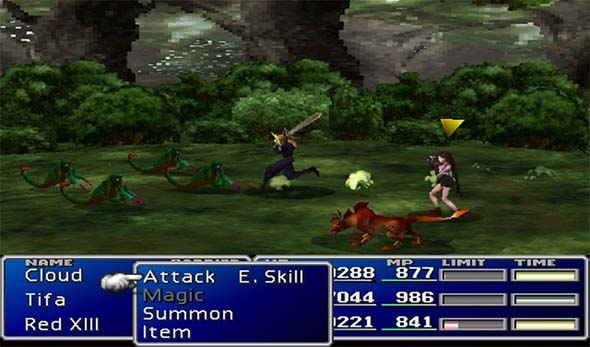
All skills and abilities (except Limit Breaks) are granted by equipping materia,
making all character functionally almost identical.
However, this materia system does have one significant drawback: It severely limits the role of the characters in the actual gameplay.
From a gameplay perspective, the characters of Final Fantasy VII are mostly blank slates. The only mechanics that are unique to characters is their weapon classes and unique limit breaks. The weapons are mostly cosmetic, since the combat mechanics don't differentiate them much. There are slight variations in the number and arrangement of materia slots between characters' weapons, but these are minor differences. Limit breaks are infrequently used and are of little consequence in the grand scheme of the game. Each character does have their own stats that improve with each level, but these improvements happen automatically and aren't influenced by player actions.
So instead of developing the characters, the player is really developing the materia. Leveling up the materia unlocks more powerful spells and abilities, and maximizing the materia allows it to duplicate and be equipped to multiple characters simultaneously.
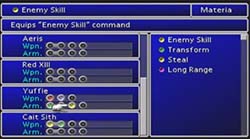
Materia can be readily hot-swapped.
The end effect is that any combination of three characters is almost functionally identical if you just equip them with the same set of materia. And since the player generally wants to use his or her best materia in any given encounter (except when deliberately grinding), it's very common to just equip any party arrangement with your preferred materia set. This effectively removes the need for having eight characters on the roster, but increases the amount of grinding and pads out the game's length.
Which characters you chose for any given situation is, thus, entirely arbitrary, and the characters themselves have virtually no personality within the actual game. Final Fantasy VII can, therefore, be viewed as two components glued together: a game about materia, and a movie (or book) about the characters. These two components have very little interaction with one another and are very disjoint.
Final Fantasy VIII develops the Guardian Forces instead of the characters
Final Fantasy VIII has a similar problem, but to a much greater extent!
In this game, materia is replaced by Guardian Forces that serve the same function: they grant abilities to the players and determine the characters' stats. Like with VII's materia, the guardian forces can be hot-swapped between characters at any given time. The Guardian Forces are also part of the game's narrative, but not quite as integral as materia is to Final Fantasy VII's plot.
In this game, leveling the characters is almost trivial, as most of your combat potential comes from junctioning drawn magic and Guardian Forces. Granted, the characters do develop affinity for certain guardian forces as they use them. Square might have added this feature because they realized the same problem with the materia system that I pointed out above, and wanted some motivation for the player to pair certain Guardian Forces with specific characters in order to create some specialization for the characters. But in my experience, this effect was fairly minimal, and didn't make or break a character.
At several key points in Final Fantasy VIII's plot, the party is required to separate [LEFT] in order to accomplish two tasks simultaneously. But you can still just re-junction [RIGHT] all the GFs between separated members anyway.
VIII creates an even greater narrative disconnect with its guardian forces, however, because at several key moments in the game's story, the party is split up. The player is tasked with assigning which characters will perform which mission. However, this decision is almost entirely moot because even after the party splits up, the characters can still swap guardian forces with the characters in the other party. Thus, you can keep your best three guardian forces equipped at all times, even though the characters are separated by a whole continent!
Again, there is no reason (in gameplay terms) to have more than three characters in this game, since the extra characters are never relevant to gameplay. Only the guardian forces are relevant. In fact, the game only gives three of the Guardian Forces automatically (one for each active party member), and the rest are optionally attained via side quests or drawing them from boss encounters. The characters all play virtually the same, and nothing of their personalities comes through in gameplay.
Final Fantasy X-2 drops the redundant characters in favor of role-switching
To get a better idea of what I'm talking about, just look at the game Final Fantasy X-2. Say what you will about the game's story and characters, but I happen to think that it has the best combat system of any of the Final Fantasy games, bar none!
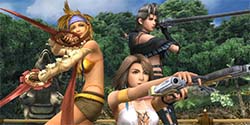
Final Fantasy X-2 has only 3 playable characters.
X-2 uses a job system in which the characters change jobs by equipping different uniforms. Each job changes their stats and grants them different powers, and the characters can change uniforms at any time - even during combat! So instead of having seven or eight characters that all fulfill the same basic few roles, X-2 reverses the paradigm and has only three characters that can change roles at any time!
This design actually fits in much better with both VII and VIII's design philosophy, since it incorporates the ability to swap roles (i.e. materia or guardian forces) on a whim without including unnecessary redundant characters.
Making each character unique and significant to the gameplay
Even the people at Squaresoft may have started to recognize the same design shortcomings that I had mentioned for VII and VIII. In the subsequent games, they came up with much more cohesive gameplay and narrative experiences by specializing the specific characters and giving them more personality and significance to the actual combat mechanics.
Final Fantasy IX has characters that learn skills
I didn't play IX as much as I played VII, VIII, X, and XII, but if I recall correctly, it did do a better job making each character relevant. In fact, it preceeded X in giving each character a dedicated class and skill set.
In this game, characters gained skills by equipping items that were imbued with the respective skill. And each character had a different set of items that he or she was allowed to equip. Once the character acquired enough experience with the equipped item, its skill would be fully memorized, and the character could continue to use that ability even without the item equipped. You could then equip the item to another character to teach the skill to them, or sell it at a shop.
Because each character had different sets of equipment that they could use, they each learned different sets of skills. True, there was some overlap, but each character retained a unique selection of spells and abilities that gave personality to their fighting style.
In addition, there are some skills that are restricted to specific characters only. For example, Vivi is the only black mage, and only Garnet and Eiko can summon Eidelons.
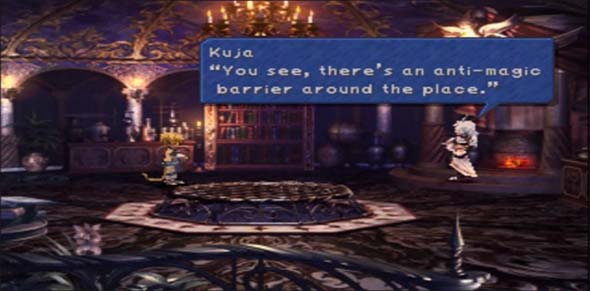
You'll have to split up the party in Final Fantasy IX, but since each character
has different skill sets and abilities, the division actually matters!
And like VIII before it, Final Fantasy IX also had several instances in which the party is split up. In these cases, it is important for the player to divide the party up intelligently so that each party has enough versatility to take on the challenges being thrown at them. You couldn't hot-swap skills like in VII and VIII. So the decision of who goes with who actually has weight and significance in the game! Or at least, that's how I remember it...
So from a design standpoint, Final Fantasy IX has one of the best-conceived party mechanics of any of the Final Fantasy games. Each character retains a sense of self-identity in both the game's narrative and its active gameplay, but the player still has opportunity to custom-tailor each character to fit your specific play-style and needs. And it was the first of the PlayStation-era entries in the series to accomplish this! Perhaps I should revisit this game sometime?
Final Fantasy X's Sphere Grid is probably the best system in the franchise
I think my favorite Final Fantasy game is probably X. It also happens to be the first one that I played. Go figure.
This game has a much more elegant character development system that better integrates the characters into the game's story.
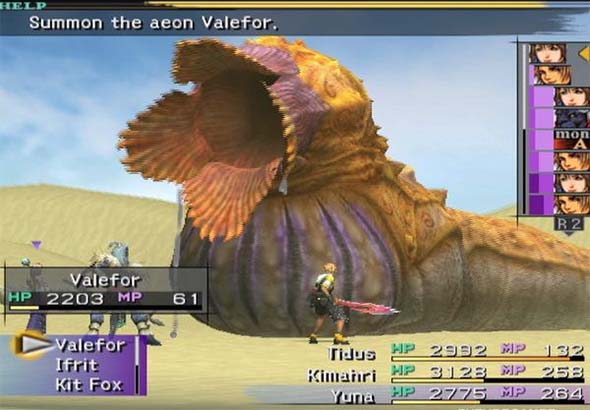
Final Fantasy X is my favorite game in the series, and has one of its best battle and character systems.
There is a single skill table, called the Sphere Grid. Every character uses this same grid, but starts the game at different places. The skill are placed along pre-determined paths, and the lines between paths are blocked by locks. Thus, each character follows a specific, pre-determined path for the majority of the game, with a few opportunities for the player to make small adjustments. Towards the end of the game, characters can start learning each other's abilities, but are still restricted to the skills that are in proximity to where they complete their own skill tree. Because of this, every character retains their own set of skills for almost the entire game, and only a few characters have opportunities to overlap skill sets (Khimari, Riku, and Auron being the most likely to "multi-class").
Yes, eventually (with enough grinding), you can fill up the Sphere Grid for every character (just like in Final Fantasy XII). However, even if you do this, there are still some abilities that are intrinsic to the character. For example, only Yuna can summon, and only Khimari can use the Enemy Skill ability.
In addition, the characters and their weapons offer variations in usefulness. For example, Wakka's ball is the only projectile weapon, so he is the only character that can reliably hit flying targets. Yuna is the summoner and white mage, and Lulu is the black mage (who can also hit flying targets, but only with magic). Auron tends to be the heavy-hitter of the group, Riku is the thief, and Tidus has a lot of support skills. Khimari is the only early-game wildcard character. He starts in a centralized location on the grid and has easiest access to other characters' skill trees (Wakka's and Lulu's being the most immediately-accessible).
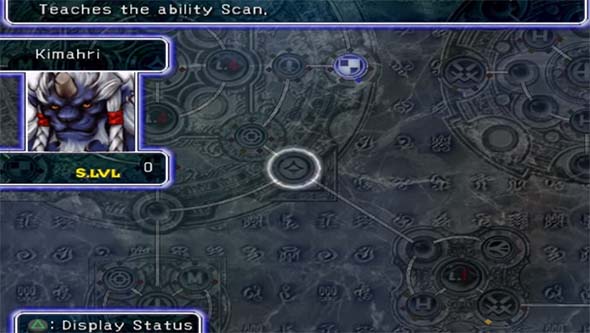
The Sphere Grid of Final Fantasy X maintained each character's unique skill set,
while also allowing some overlap.
Because of these features of the design, each character maintains their own unique role in combat, and this role is informed by the character's personality and history. During any given combat encounter, the player can even swap characters in and out of the active party. This can be done either to replace a weakened or KO'd character, or to use that character's unique abilities. Every character is thus useful in battle in their own way (except maybe Khimari), the player is incentivized to upgrade every character, and the presence of seven characters actually matters within the game!
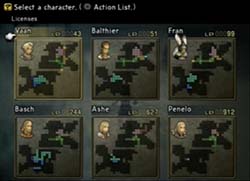
All characters in Final Fantasy XII share the same skill board and can all use the same "Gambits".
Final Fantasy XII tries to be customizeable
Final Fantasy XII falls into a middle ground.
In this game, all six characters share a single skill table. They all start with a different set of skills in this table, and can only add new skills that are adjacent to the ones they already have. So at the beginning of the game, each character feels different. However, the skill grid is too small, and by about halfway through the game, the characters have leveled to a point that there is a lot of overlap. By the end of the game, every character is functionally almost identical.
The scripts that are used to determine their in-game actions (called "Gambits") can also be swapped between characters at any time. So once again, there is little need for having more than three characters, since they end up feeling the same anyway. This game wasn't quite as bad about this as VII or VIII, since the character stats are more meaningful and the dedicated ranged characters play a little differently than the melee ones.
One thing that is not swappable, however, is Espers (summons). Any character can learn any given Esper, but once any single player learns it, it is removed from all other players' license boards. So this is one area where you can give permanent specialization to specific characters, if you chose.
Final Fantasy XII tries to strike a balance between the other games' development systems. The License Board is similar to X's Sphere Grid, and the characters' weapons give them different tactical value. But having every player share the same License Board seems to be an attempt to mimic VII's materia by allowing all characters to learn any given ability. The exception is Espers, which are permanently bonded to a specific character; whereas VIII's Guardian Forces only vary slightly in strength from character to character, but can be equipped to anyone.
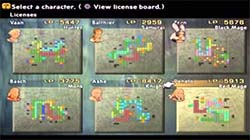
The International version requires each
character to take a unique job
So the utility of each individual character is somewhat in the hands of the player. You can chose to specialize certain characters towards the Espers or specific weapons. Or you can chose to keep each character well-rounded so that any party of three will have almost the same combat potential. So whether the characters end up feeling bland and redundant is dependent on how the player develops them.
The International Zodiac Job System re-release sought to further specialize the individual characters by forcing them to permanently chose a job that gives them access to a unique license board. I never played the International version, so I can't comment on how successful this ended up being.
This is why Final Fantasy X remains my favorite game in the series
So what does all this really mean to gameplay?
Well, one significant impact on gameplay is whether or not the game's mechanics encouraged me to revive characters that had been KO'd. Final Fantasy VII offers the least incentive to revive a character, since their materia can easily be moved to a backup character (of which I had five available)! VIII was similar, but in the parts where the party is split up, there is more pressure to revive a character since I didn't have any backups available.
In X, immediately reviving any fallen character was always high priority (unless that character was Khimari), because every character has unique utility within combat. The next random encounter might require the unique abilities of a specific character. IX was similar, but not quite to the extent of X. On top of that, since every character in X could be used in any given battle, there was incentive to revive the character during battle in order to ensure that they all gain experience and avoid having to grind with that character later. In all the other games, you'd have to grind with some characters anyway, so it didn't matter as much if a character fell in a particular battle and didn't gain exp.
Giving each character unique functionality within battles created a deeper bond with the characters of Final Fantasy X for me and greatly increased the enjoyment that game gave me. The idea of Yuna leaving the party to marry Seymour or sacrificing herself to stop Sin made me orders of magnitude more sad than the surprise death of Aerith or Rinoa's coma because I felt much more connected to Yuna through the gameplay.
Yuna's marriage to Seymour [TOP] and possible sacrifice to fight Sin had far more weight than
Aerith's death [BOTTOM LEFT] or Rinoa's coma [BOTTOM RIGHT] because Yuna wasn't as easily replaceable.
She (and every character in X's roster, except Khimari) was important to the gameplay, and having her unavailable (for any reason) felt like a much greater loss. The deeper connection to the characters of X also made me much more interested in X-2 (as silly as it is) than Advent Children or Dirge of Cerberus or Crisis Core or any of the dozen Final Fantasy VII spin-offs because I just don't care as much about any of VII's characters.
But even though some of these games had missteps in their design, none of them turned out as monumentally bad as Final Fantasy XIII! That game makes the same narrative mistake that VII and VIII made by making the gameplay contradict the story, and it manages to be a terrible game with terrible characters to boot. How did that game get a sequel?!
With Final Fantasy XV right around the corner (release date not yet specified), we'll see if Square-Enix has learned any lessons. Hopefully, the new game can learn from the mistakes of the series' past (including the mistakes of the good games) and return Final Fantasy to its former glory.
Hopefully, Square-Enix has learned some lessons from its past mistakes,
and will more carefully combine the story and gameplay for Final Fantasy XV.